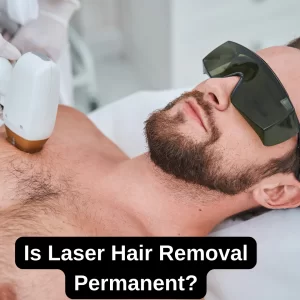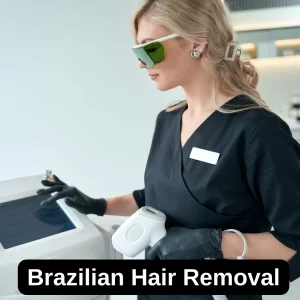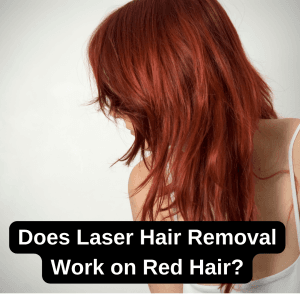Laser hair removal is a popular choice for those seeking long-lasting hair reduction. Unlike temporary methods like shaving and waxing, laser hair removal targets hair follicles to significantly slow or stop hair growth. Results can vary depending on individual factors such as hair type, skin type, and the area being treated. Generally, laser hair removal can offer smooth skin for an extended period, lasting anywhere from 6 months to several years with proper maintenance.
While laser hair removal doesn’t guarantee 100% permanent removal, it offers a substantial reduction in hair growth with consistent sessions. Maintenance sessions are typically recommended once or twice a year to keep regrowth minimal. Long-lasting results depend on understanding the procedure, factors influencing success, and how different body areas respond to treatment.
How Many Sessions Are Needed for Long-Lasting Results?
The effectiveness and longevity of laser hair removal depend on the number of sessions completed. A series of 6 to 8 sessions is generally recommended for noticeable, long-lasting results. Each session targets hair follicles in the active growth phase (anagen phase), and since hair grows in cycles, multiple sessions are essential to treat all follicles effectively.
For individuals with darker hair and lighter skin, fewer sessions may be needed due to better absorption of laser energy. However, those with lighter hair or darker skin may require additional sessions to achieve optimal results. Here’s a general guideline for different hair and skin types:
- Light Skin with Dark Hair: 5-7 sessions
- Medium Skin with Dark Hair: 6-8 sessions
- Dark Skin with Dark Hair: 8-10 sessions, often with specialized lasers like Nd
- Light Hair (Blonde/Gray): Results may vary; additional sessions or alternative treatments like electrolysis may be more effective.
Following the initial treatments, maintenance sessions every 6 to 12 months can prolong results.
For those interested in electrolysis sessions:
How Many Sessions for Electrolysis?
Can Laser Hair Removal Be Permanent?
Laser hair removal results can be long-lasting; however, the body has a certain regenerative ability. Research has shown that in some cases, the body can activate “dormant stem cells” to regenerate hair follicles that were previously damaged by laser treatment. Although this doesn’t occur in everyone, some people may notice fine, light hairs returning after a few years. This explains why, for some individuals, laser hair removal may not always achieve 100% permanent results.
Laser hair removal is often considered a semi-permanent solution. This means it significantly reduces hair growth but may not eliminate every follicle forever. Many people experience smooth skin for extended periods, but some hair may regrow over time, especially if hormonal changes occur, such as during pregnancy or menopause.
How Long Does Laser Hair Removal Last on Different Body Parts?
The longevity of laser hair removal results can vary by body part. Areas with coarse, dense hair or hormonal influence may require more sessions or maintenance.
| Body Area | Longevity (Duration) | Maintenance Frequency |
| Bikini Area (Brazilian) | 6 months – 2 years | Annually |
| Underarms | 1 – 2 years | Annually |
| Face | 6 – 12 months | Every 6 – 12 months |
| Legs | Up to 2 years | Every 12 – 18 months |
| Arms | 1 – 2 years | Every 12 months |
| Chest, Back, and Stomach | 1 – 2 years | Every 6 – 12 months, depending on density |
Bikini Area (Brazilian)
For the Brazilian or bikini area, laser hair removal can last between 6 months to 2 years after the initial treatment course. Hair in this region is often denser and hormonally influenced, so maintenance sessions are typically needed annually. If you’re considering Brazilian laser hair removal, explore how long Brazilian laser hair removal results last to know what to expect.
Underarms
Laser hair removal for underarms is generally effective, lasting around 1 to 2 years post-treatment. The coarse hair here responds well to laser treatment, and results can be long-lasting with maintenance.
Face
Facial hair removal, especially on the upper lip, chin, and jawline, can be challenging due to hormonal factors. Typically, results last 6 to 12 months before maintenance is needed.
Legs
Leg hair is often coarser, and laser treatments can last up to 2 years with minimal maintenance. A touch-up session every 12 to 18 months helps maintain smooth legs.
Arms
Laser hair removal for arms offers results that last about 1 to 2 years. Since arm hair is lighter and finer, more frequent maintenance may be necessary.
Chest, Back, and Stomach
For areas like the chest, back, and stomach, laser hair removal typically lasts 1 to 2 years. These areas may require more maintenance, especially in men, due to dense, hormonally influenced hair growth.
Factors That Affect the Longevity of Laser Hair Removal Results
One important factor affecting laser hair removal results is the skin’s hydration level. Dry skin can make laser energy less effective because moisture improves the skin’s ability to absorb laser light. Ensuring that the skin is well-moisturized before and after treatment can enhance results. Some clinics even recommend pre-treatment moisturizing sessions to boost the laser’s effectiveness, which can be particularly useful for individuals with dry skin types.
| Factor | Impact on Longevity | Recommendation |
| Hair Color | Dark hair absorbs more laser energy, leading to better results | Suitable for darker hair; consider alternative treatments for lighter hair |
| Skin Tone | Lighter skin tones achieve higher effectiveness due to contrast | Use Nd for darker skin tones to reduce risks |
| Hormonal Changes | Pregnancy, menopause, or hormonal imbalances can trigger regrowth | Consider touch-up sessions as needed |
| Body Area | Areas like the face may require more frequent sessions due to sensitivity to hormones | Schedule regular touch-ups for facial areas |
| Laser Type | Alexandrite and Diode provide longer-lasting results for light to medium skin tones | Choose laser type based on skin and hair type |
| Treatment Consistency | Regular sessions yield better results and longer-lasting reduction | Follow recommended session intervals |
Several factors impact the durability of laser hair removal results:
- Hair Color and Thickness: Dark, coarse hair absorbs laser energy more effectively, leading to better results. Lighter or fine hair may not respond as well.
- Skin Type: Those with lighter skin and darker hair typically see the best results. Darker skin tones may need specialized lasers (e.g., Nd
) and could require more sessions.
- Hormonal Influences: Hormonal changes, such as pregnancy or menopause, can stimulate hair regrowth in hormone-sensitive areas.
- Laser Type Used: Different laser types (e.g., Alexandrite, Diode, Nd
) vary in effectiveness based on skin tone and hair type, influencing the longevity of results.
- Consistency of Sessions: Following a regular treatment schedule increases the likelihood of achieving long-lasting results.
Which Laser Hair Removal Technique Lasts the Longest?
Laser techniques offer varying levels of effectiveness and longevity. Here’s a breakdown of the most common laser types:
| Laser Type | Best Suited For | Longevity (Duration) | Hair Reduction Rate | Maintenance Frequency |
| Alexandrite Laser | Light to medium skin, dark hair | 1 – 2 years | 70-85% | Annual or bi-annual |
| Diode Laser | Wide range of skin types | 1 – 2 years | 80-90% | Once per year |
| Nd Laser | Darker skin tones | 1 – 1.5 years | 70-80% | Every 6-12 months |
| Ruby Laser | Fine, light hair | 1 year or less | 60-75% | Every 6-12 months |
| IPL (Intense Pulsed Light) | Light skin, dark hair | 6-12 months | 50-70% | Every 3-6 months |
Scientific Support and Explanation
- Alexandrite Laser
Wavelength: 755 nm
Effectiveness: Achieves up to 85% hair reduction after a full course of treatment.
Suitability: Best for individuals with light skin and dark hair due to the high contrast that allows effective targeting of hair follicles.
Operational Principle: Utilizes a concentrated beam of light that targets melanin in hair follicles, effectively heating and destroying them.
Advantages: Fast treatment time; can cover large areas efficiently; FDA-approved for permanent hair reduction.
Considerations: May require multiple sessions for optimal results and annual maintenance sessions to sustain hair reduction.
Alexandrite lasers are particularly effective for individuals with light skin and dark hair. Research published in the Journal of the American Academy of Dermatology has demonstrated that Alexandrite lasers can achieve up to 85% hair reduction in suitable candidates after a full course of treatment. Additionally, Alexandrite lasers are FDA-approved for permanent hair reduction, reinforcing their efficacy and safety for lighter skin tones with darker hair.
- Diode Laser
Wavelength: 800-810 nm
Effectiveness: Can achieve 80-90% hair reduction, especially effective for thicker and denser hair.
Suitability: Versatile for a wide range of skin types, including medium to darker skin tones.
Operational Principle: Delivers concentrated light energy that penetrates the skin to target and damage hair follicles.
Advantages: Effective on various hair types; provides long-lasting results; typically less painful than other methods.
Considerations: May require touch-up sessions annually to maintain results.
Diode lasers work well across various skin types, including darker tones, and provide long-lasting results. A study in Dermatologic Surgery found that Diode lasers could achieve 80-90% hair reduction in patients, particularly effective for areas with thicker, denser hair. This versatility makes Diode lasers a preferred choice for both light and dark skin tones, and they maintain results with annual touch-ups.
- ND Laser
Wavelength: 1064 nm
Effectiveness: Achieves 70-80% hair reduction; slightly more frequent touch-up sessions may be necessary.
Suitability: Particularly safe and effective for individuals with darker skin tones.
Operational Principle: Uses a longer wavelength to penetrate deeper into the skin, minimizing the risk of burns while targeting the hair follicles.
Advantages: Effective for deeper hair follicles; lower risk of skin damage; suitable for tanned skin.
Considerations: May require more sessions than Alexandrite lasers for optimal results.
Ndlasers are especially safe and effective for individuals with darker skin tones. According to research published in Lasers in Surgery and Medicine, Nd
lasers achieve around 70-80% hair reduction but may require slightly more frequent touch-up sessions compared to Alexandrite and Diode lasers. Due to its 1064 nm wavelength, Nd
penetrates deeper into the skin, minimizing the risk of burns and hyperpigmentation, which makes it a safe choice for darker skin types.
- Ruby Laser
Wavelength: 694 nm
Effectiveness: Provides around 60-75% hair reduction.
Suitability: Ideal for light skin tones and finer hair.
Operational Principle: The shorter wavelength allows for precise targeting of hair follicles, effectively removing hair at the root.
Advantages: Effective for fine hair; fast treatment times; precise targeting.
Considerations: Less effective on darker skin tones; requires more frequent maintenance sessions.
Ruby lasers were one of the first types developed for hair removal and are particularly effective for lighter, finer hair. According to a study published in the International Journal of Dermatology, Ruby lasers provide around 60-75% hair reduction, making them suitable for those with light skin and finer hair. However, due to their lower penetration depth and limited effectiveness on darker skin tones, Ruby lasers typically require more frequent maintenance sessions compared to other laser types.
- IPL (Intense Pulsed Light)
Wavelength: 500-1200 nm (broad spectrum)
Effectiveness: Achieves approximately 50-70% hair reduction.
Suitability: Best suited for light skin tones with dark hair due to the light contrast.
Operational Principle: Emits a broad spectrum of light that targets the melanin in hair follicles, disrupting their growth.
Advantages: Can treat larger areas quickly; suitable for various hair types; can also address skin pigmentation issues.
Considerations: Less effective than laser treatments; often requires more frequent sessions to maintain results.
Although not technically a laser, IPL is commonly used for hair removal on lighter skin tones with dark hair. Research published in the Journal of Cosmetic and Laser Therapy demonstrated that IPL can achieve approximately 50-70% hair reduction in suitable candidates. However, IPL treatments generally have a shorter duration of effectiveness compared to professional laser options and often require more frequent sessions to maintain results. IPL devices are widely available for home use, although they are less intense than professional-grade treatments, which may affect their long-term efficacy.
For more insights on laser waxing:
What Is Laser Waxing?
How to Permanently Destroy Hair Follicles: A Comparison of Laser Hair Removal and Other Methods
Understanding the different methods available for hair removal is crucial for those seeking long-lasting results. This section compares laser hair removal with various other techniques, such as electrolysis, IPL, and traditional methods like waxing and plucking. Each method has its own effectiveness, longevity, and suitability based on hair and skin types. By evaluating these options, readers can make informed decisions on how to permanently destroy hair follicles and achieve their desired hair reduction goals. Whether you’re considering professional treatments or at-home solutions, this comparison will guide you in choosing the most effective approach for your unique needs.
| Method | How It Works | Effectiveness | Longevity | Ideal For |
| Laser Hair Removal | Uses laser light to heat and damage hair follicles | High (up to 85%) | Long-term (1-2 years with maintenance) | Dark hair on light to medium skin |
| Electrolysis | Electric current destroys each hair root individually | Very High (90-100%) | Permanent | All hair and skin types |
| IPL (Intense Pulsed Light) | Broad-spectrum light damages hair follicles | Moderate (50-70%) | Short-term (6-12 months) | Light skin with dark hair |
| Depilatory Creams | Chemically dissolves hair at the skin surface | Low | Very Short (days to weeks) | Small areas, temporary removal |
| Waxing/Sugaring | Removes hair from the root | Moderate | Short-term (3-6 weeks) | All hair types, temporary removal |
| Thermolysis | High-frequency current heats and damages follicles | High | Long-term (varies by individual) | Facial areas, fine hair |
| Plucking/Tweezing | Manually pulls hair from the root | Low | Short-term (2-4 weeks) | Small areas, occasional use |
| Prescription Creams | Slows hair growth by inhibiting enzymes | Moderate | Varies (requires continuous use) | Facial hair |
| Laser Cap Treatments | Emits low-level light therapy for hair removal | Moderate | Short-term (6-12 months) | Small areas, convenience use |
| Cryotherapy | Freezes hair follicles to damage them | Experimental | Long-term (unknown) | Not widely used |
| Herbal Remedies | Uses natural extracts to inhibit growth | Low | Varies widely | Minor hair growth reduction |
Explanations
Laser Hair Removal: This method utilizes concentrated light to target melanin in hair follicles, effectively working to destroy hair follicles and significantly reduce hair growth. It is particularly effective for individuals with dark hair and light skin due to the contrast, which allows the laser to target the hair more efficiently. Multiple sessions are necessary to achieve optimal results, as hair grows in cycles, and some hair follicles may remain dormant during initial treatments. Regular maintenance sessions, typically required annually, can further enhance the longevity of the results, helping to maintain a smoother skin surface over time.
Electrolysis: As the only FDA-approved method for permanent hair removal, electrolysis is a highly effective approach to destroying hair follicles on a permanent basis. It involves inserting a fine probe into each hair follicle and applying a precise electric current that destroys the root. This method is suitable for all hair and skin types, making it a versatile option. However, electrolysis can be time-consuming due to the individual treatment of each follicle and may cause some discomfort during the procedure. Its effectiveness in permanently destroying hair follicles makes it an excellent choice for those seeking lasting results.
IPL (Intense Pulsed Light): Similar to laser hair removal, IPL uses broad-spectrum light to target and damage hair follicles. While it is effective in reducing hair growth, IPL is generally less effective than traditional laser treatments and may require more sessions to achieve the desired results. It works best on individuals with light skin and dark hair, as the contrast enhances its effectiveness. Although IPL treatments are a viable option for destroying hair follicles, they often fall short compared to more concentrated laser methods.
Depilatory Creams: These over-the-counter products work by chemically breaking down the protein structure of hair, allowing it to be easily wiped away. While they provide a painless hair removal option, the results are only short-term, typically lasting just a few days to weeks. Furthermore, depilatory creams may cause skin irritation or allergic reactions, particularly for sensitive skin types. They do not effectively destroy hair follicles and are best used for temporary hair removal.
Waxing/Sugaring: Both methods involve applying a sticky substance to the skin and swiftly removing it to pull hair out from the root. Waxing and sugaring can yield longer-lasting results than shaving but may be painful and can lead to ingrown hairs. While they do remove hair at the follicle level, they do not have a permanent effect on destroying hair follicles. These methods are effective for temporary hair removal but may require repeated sessions to maintain smooth skin. Curious whether waxing or an epilator delivers longer-lasting results? This in-depth guide breaks down the pros and cons of each method.
Thermolysis: A form of electrolysis, thermolysis utilizes high-frequency current to generate heat that destroys hair follicles. This method is effective, particularly for fine hair and facial areas. However, it requires a skilled practitioner to minimize the risk of skin damage. Thermolysis provides a way to destroy hair follicles, contributing to long-term hair reduction, but may not be as widely accessible as other methods.
Plucking/Tweezing: This manual hair removal method involves using tweezers to pull hair out from the root. While suitable for small areas, it is time-consuming and can lead to ingrown hairs if not performed correctly. Plucking does not destroy hair follicles permanently, necessitating regular maintenance for continued hair removal.
Prescription Creams: Certain topical medications, such as Eflornithine, inhibit the enzymes necessary for hair growth, effectively slowing down the hair production process. Primarily used for facial hair, these creams require continuous application to maintain their effects. While they can help manage hair growth, they do not provide a permanent solution for destroying hair follicles.
Laser Cap Treatments: These devices emit low-level light therapy aimed at at-home hair removal. Their effectiveness in destroying hair follicles can vary significantly, and they are generally not as powerful as professional treatments. Regular use is necessary to see results, but users should temper their expectations regarding efficacy.
Cryotherapy: This method involves freezing hair follicles to damage and potentially destroy them. Currently considered experimental, cryotherapy is not widely used and requires more research to establish its effectiveness and safety.
Herbal Remedies: Various natural extracts claim to inhibit hair growth, with some aiming to destroy hair follicles. However, many of these remedies lack scientific backing, and results can be inconsistent. While they may provide some temporary relief, they are not reliable for long-term hair removal or for effectively destroying hair follicles.
This comprehensive overview of various hair removal methods highlights their effectiveness in destroying hair follicles and provides insights into the longevity of results, ensuring that individuals seeking lasting hair reduction can make informed choices.
How Often Will You Need Maintenance Sessions After Laser Hair Removal?
Most individuals benefit from annual maintenance sessions to maintain smooth skin, although some may need touch-ups every 6 to 12 months. Maintenance needs vary by body area and personal factors like hormonal fluctuations.
Permanent Hair Removal at Home: Is It Possible?
For those seeking the convenience of at-home hair removal, several high-quality devices offer significant hair reduction with consistent use. Here’s an overview of popular options and tips for optimizing results.
At-Home Hair Removal Devices: Options and How They Work
At-home IPL (Intense Pulsed Light) devices are the most common tools marketed for long-term hair reduction. Unlike professional lasers, IPL devices emit broad-spectrum light, targeting melanin in hair follicles to disrupt growth.
IPL (Intense Pulsed Light):
- How It Works: IPL devices emit light that penetrates the skin and disrupts the follicle’s ability to produce new hair.
- Suitability: Best for individuals with light to medium skin tones and dark hair.
Best for individuals with light to medium skin tones and dark hair. To learn more about how IPL works and whether it’s right for you, visit: https://www.epilationworld.com/intense-pulsed-light-laser-guide/
Tips for Effective At-Home Hair Removal
- Follow a Consistent Schedule: Use the device every 2-4 weeks initially, then reduce as needed.
- Pre-Shave the Treatment Area: Shave to ensure the light reaches the follicle.
- Choose the Right Settings: Start at lower intensity for sensitive areas.
How At-Home Results Compare to Professional Treatments
When it comes to hair reduction, at-home devices provide a convenient and accessible alternative for individuals who prefer to manage their grooming routines without the need for frequent salon visits. However, it is essential to recognize that these at-home options generally lack the power and intensity found in professional laser treatments. Understanding the differences between these two approaches can help consumers make informed decisions about their hair removal methods.
Power and Intensity
Professional laser treatments utilize advanced technology that delivers higher energy output and more concentrated laser beams. These professional devices penetrate deeper into the skin, effectively targeting the hair follicles at a more profound level. This increased intensity is crucial for achieving optimal results, particularly in terms of permanent hair reduction. In contrast, at-home devices, while effective for some users, often operate at lower power levels, making them less effective for achieving the same level of hair reduction that professionals can provide.
Effectiveness and Longevity
While at-home devices, such as IPL (Intense Pulsed Light) systems, can lead to significant reductions in hair growth, they may not achieve permanent results on par with professional treatments. Studies indicate that professional laser treatments can yield up to 85% hair reduction after a series of sessions, while at-home devices may produce a lower percentage of reduction. Users should be aware that, although at-home treatments can be beneficial, they often require more frequent applications to maintain results.
Regular usage of at-home devices is critical for achieving satisfactory outcomes. Typically, individuals are advised to use their devices every 2-4 weeks initially, then adjust the frequency based on their hair growth patterns and the results they observe. This commitment to consistent use is essential to mimic the effectiveness of professional treatments, where hair is targeted more thoroughly.
Skin and Hair Type Considerations
Another critical factor to consider is the suitability of at-home devices for various skin and hair types. At-home IPL devices are most effective on individuals with light skin and dark hair, as the contrast allows the device to target the hair follicles more efficiently. Those with lighter hair or darker skin tones may find at-home treatments less effective due to insufficient contrast. In contrast, professional treatments can be tailored to accommodate a broader range of skin and hair types, utilizing specialized lasers to ensure optimal results regardless of the individual’s characteristics.
Realistic Expectations
It is important for users of at-home hair removal devices to maintain realistic expectations regarding the level of hair reduction they can achieve. While these devices can significantly reduce hair growth and improve skin smoothness, they may not deliver the same permanence that professional treatments offer. Individuals seeking a long-term solution may find themselves requiring periodic touch-up sessions to maintain their desired results.
Cost-Effectiveness and Convenience
One of the primary advantages of at-home devices is their cost-effectiveness. While the initial investment in a quality at-home device can be significant, it is typically less than the cumulative costs of multiple professional sessions. Moreover, the convenience of being able to perform hair removal treatments in the privacy of one’s home is appealing to many users. At-home devices allow for flexibility in scheduling treatments, making it easier to integrate hair removal into busy lifestyles.
Ultimately, for individuals with light skin and dark hair, at-home IPL devices present a practical and efficient way to manage hair growth while enjoying the convenience of home treatments. While they may not match the effectiveness and longevity of professional treatments, they still offer a viable option for those looking to reduce hair growth. By understanding the limitations and proper usage of at-home devices, users can make the most of their hair removal journey and work towards achieving smoother skin.
Investing in at-home hair removal technology can empower individuals to take control of their grooming routines, but it is crucial to remain informed about the differences between at-home and professional treatments to set realistic goals and expectations.
Conclusion: Embracing Permanent Hair Removal Choices for Lasting Results
In the quest for smooth, hair-free skin, understanding the variety of hair removal methods is paramount. Laser hair removal stands out as a highly effective option for those seeking permanent results, particularly when complemented by proper maintenance and adherence to recommended treatment schedules. Whether you’re exploring professional treatments or considering at-home solutions, each method presents unique advantages and limitations.
As we’ve discussed, factors such as skin type, hair color, and personal preferences play a crucial role in determining the most suitable hair removal approach. For individuals with light skin and dark hair, laser hair removal may yield impressive results, while those with different skin or hair characteristics might find alternatives like electrolysis or IPL more effective.
It’s essential to set realistic expectations when it comes to hair reduction. While at-home devices offer convenience and affordability, they may not achieve the same permanence as professional treatments. However, with consistent use and proper care, these devices can still provide significant improvements in hair growth management.
Ultimately, the best approach to hair removal is one that aligns with your lifestyle, goals, and skin needs. By weighing the options available, you can make informed decisions that empower you to take control of your grooming routine. Whether you choose professional services or at-home devices, the journey towards achieving permanent smooth skin is now more accessible than ever. Embrace the method that suits you best, and enjoy the confidence that comes with lasting hair reduction. Visit Epilation World for More Hair Removal Insights

Meet the Epilation World Expert Team
Our team consists of certified professionals with over 17 years of experience in laser hair removal, skincare, and personal care. With advanced training in diode laser, IPL, waxing, and skin health, we combine clinical precision with real-world expertise to deliver reliable, evidence-based guidance.
Every article is carefully created and reviewed by our experts to ensure safety, clarity, and scientific accuracy. Our work has helped thousands choose safe, effective hair removal solutions tailored to their unique needs.
Trusted expertise. Real results. That’s our promise.





